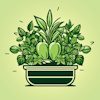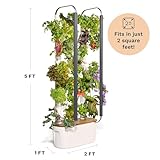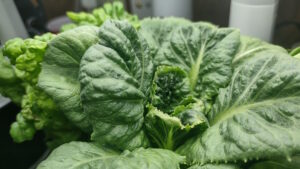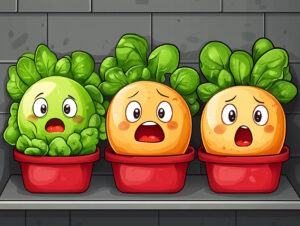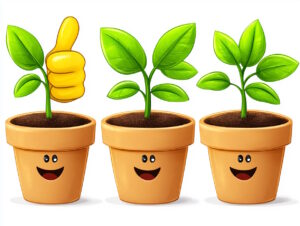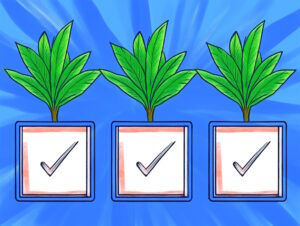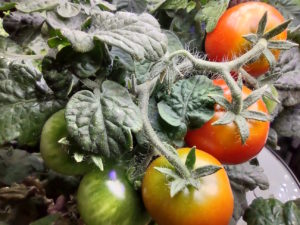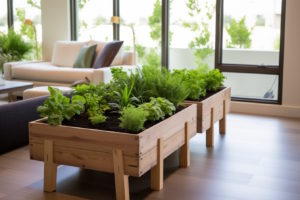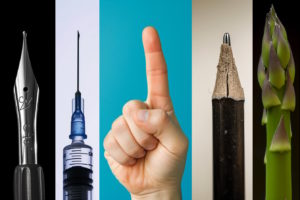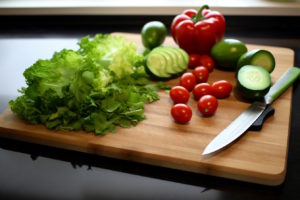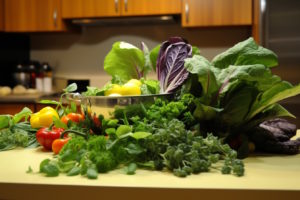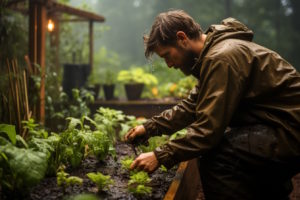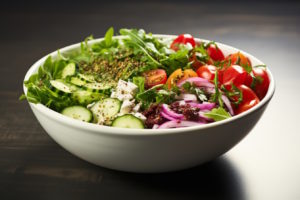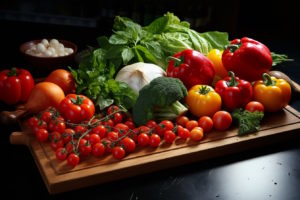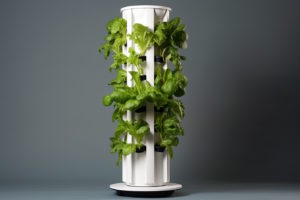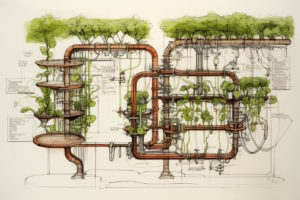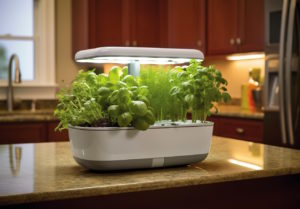What Can I Grow with My Indoor Garden?
If you’ve never given much thought to just how diverse your indoor garden can be, prepare yourself to be amazed. The variety of plants your indoor garden can grow is greater than can be listed in this article. Hopefully, the list of plants included below can do justice to what your indoor garden is capable of providing you.
Three Ways To Grow Food Indoors
This article focuses on the three major options for growing food indoors. If you are just starting off with an indoor garden, you’ll employ one, two, or all three techniques. The three major techniques for growing food indoors are hydroponics, soil, and microgreens.
Hydroponics
Hydroponics is broadly defined as growing plants with their roots submerged in water or periodically washed over with water. Hydroponics uses no soil. Plants absorb nutrients you add to the water supply.
Hydroponics takes on two major categories. You can wash water over the roots of the plants, leaving the plants’ roots in the air between washings. That’s one option. You’ll typically see this in large-scale operations, either residential or commercial. The plants occupy cups set in holes drilled on the top side of pipes laid horizontally and the water flows through the pipes, wetting the plants’ roots.
The other option is to leave the roots submerged in water. Some roots remain above the water line to provide the plant oxygen. Some very popular products called hydroponic growing systems use this hydroponic method combined with built-in LED grow lights to form a self-contained garden.
You can employ either hydroponic technique in your home, but the hydroponic growing systems are designed to be easily set up, operated, and maintained by the average person.
Soil-substitute mixture
The “soil” used to grow plants indoors is never dirt brought in from outdoors. Any mention of soil below refers to a soil-substitute mixture found to encourage plant growth. Exact ingredients and quantities of ingredients in a soil-substitute mixture vary, but peat moss and vermiculite are commonly recommended.
While you could drop a plant into a pot filled with soil, pour water on it, and call that good, there are better techniques available to you that improve your chances of a bountiful crop.
By employing a self-watering planter combined with a precise soil-substitute mixture and fertilizer, you’ll typically see vastly healthier plants that grow quicker than will grow in dirt using traditional techniques. For your indoor garden, these self-watering planters are the way to go.
Microgreens
A microgreens garden consists of a large quantity of seeds grown with the intention of harvesting very young plants. The entire plant is the crop, and the harvest is the entire forest of baby plants. Microgreens are a healthy addition to salads and recipes.
You can grow microgreens with a flat tray under a grow light, with a hydroponic growing system using a special tray, or in a mason jar using a special lid.
Your microgreens garden can be as large as you have room for it or as small as you want for the occasional treat. You can buy bags of seeds either as a variety or specific plants.
Hydroponic Growing System
A hydroponic growing system is a water tub, a LED grow light, and a pump to circulate water to the plants. Plants grow through holes in the tub’s lid so their roots dangle in the water. Timers regulate the light, water pump, and feeding reminders. Sensors monitor water level. A hydroponic growing system is a system, not a passive container.
These self-contained hydroponic gardens typically grow 6–12 plants on about one square foot of countertop space. Larger systems can hold 24 or more plants, but are engineered to sit on the floor like end tables.
Manufacturers have made hydroponic growing systems into inexpensive, effective, efficient, and convenient stand-alone indoor gardens. Dozens of companies offer their versions of Hydroponic Growing Systems.
EarthBox: Soil-Substitute Mixture
A self-watering container is a planter that holds soil in a chamber above a water reservoir and moves water up to the plant’s roots through some wicking mechanism. You pour water down a tube into the reservoir. The wicks draw the water up into the soil. The wicking encourages the plant to grow roots down. The plant gets water without its roots being soaked. You simply keep the water reservoir from going dry.
Now if you fill the self-watering container with a carefully mixed soil-substitute, and then apply a measured supply of slow-release fertilizer to the surface of the soil, you have created an extremely plant-friendly garden.
Plants grown using this system should grow healthier and quicker than in the traditional dirt-based outdoor garden because you have given them almost every possible advantage. They’re well-fed and properly watered in a weed-free environment. And by setting up this garden indoors, you eliminate weather as a factor, giving your plants yet another significant advantage.
EarthBox products are self-watering gardens combined with a system that includes precise soil-substitute mixtures, fertilizer, and a cover to prevent competition from weeds and hold in the moisture. You follow the system and you are almost guaranteed of getting great plants.
The EarthBox can be used indoors when combined with a LED grow light and a cup to capture any overflow water escaping the reservoir. The light replaces sunlight for the plants. The EarthBox planter has a hole high up on the water reservoir to prevent you from overfilling the reservoir, so set a cup to catch overflow water and stop pouring water when the reservoir fills up.
The EarthBox series of products represents the self-watering planter market with distinction, but is certainly not alone. You can buy self-watering planters from other manufacturers. The EarthBox as a system certainly enhances your chances of success with your garden, though.
Check out the companion article, A Raised Bed Garden Indoors? Bring It On!.
Plants You Can Grow Indoors
This article opens your eyes to the many types of plants you can grow indoors. You may find some plants on the list you’ve never considered growing indoors. Hopefully, you’ll be inspired to try it yourself.
Categories break up the list of plants into manageable chunks. The categories loosely describe the plants. While some (many) plants may truly belong in multiple categories, no plant is listed twice. Some subsets of plants are listed along with the main group simply because people may seek them out specifically.
Most plants in these lists can be grown in a hydroponic growing system or a self-watering soil-substitute container with a LED grow light. Some require special accommodations due to their size or nature of growth.
Note that the list is generally limited to food plants. Obviously, you can grow many more plants indoors than are listed, including flowers and medicinal plants such as aloe vera. A hydroponic growing system or a self-watering planter can just about do it all. It’s your garden; try new things!
And, as always, before you add a plant to your garden, know if it is safe for children and pets.
- NEXT-LEVEL GROW SYSTEM: Using Aerospring’s patented aeroponic technology, this all-in-one grow system doesn’t require any additional components to grow like a pro. The root zone is contained in the modular vertical pole, and allows the plant’s roots to grow to their greatest potential. In addition to the Aerospring aeroponic system, the grow kit comes with everything you would expect including: 180W grow light, quiet exhaust fan, carbon-filter, metal frame, D600 grow tent.
- HIGH QUALITY 180W LED GROW LIGHT: The all new, Aerospring Hexglow custom 180W custom LED light panel, full-spectrum, professional grow lights, highly efficient at 2.7 (umol/J), light intensity at 1272 PPFD (μmol/s) at 15in, CRI >90, CCT = 4000k, estimated lifespan 50,000 hours. Suitable spectrum for all stages of plant growth. 0-100% light dimmer included. Adjustable light height can be raised as the plant canopy grows.
- DESIGNED BY GARDENERS, FOR GARDENERS: We designed the Aerospring system to be the most usable hydroponic system. Easy access to the water reservoir for water management. The 20 gallon reservoir requires less frequent refilling. Easily detachable internal hose for draining/changing water. The vertical pole is easy to disassemble for cleaning and reassembly, and dishwasher safe. The wheelbase allows for easy movement and rotation for trimming leaves.
- TEMPERATURE CONTROLLED: 4" carbon air filter with Australia virgin charcoal, changeable pre-filter. Quiet 4" inline duct fan with 0-100% variable speed controller, cutting edge brushless EC Motor and dual jet type blades, delivers 160 CFM airflow rate using just 18 watts at maximum speed for discreet and high performance growing.
- GROW TENT FOR DISCREET GROWING: The fully sealable grow tent made with Oxford D600 tent material, with highly reflective white interior panels, increases plant growth while eliminating 100% of light seepage. Two colors available, gray and black, to fit with any interior.
- IN THE BOX: The Aerospring Grower’s Edition Indoor Hydroponic System includes the Aerospring patented vertical pole with 9 plant capacity, 20gal bucket & lid, Aerospring Hexglow custom 180W LED light panel and driver, Quiet 4" inline duct fan, 4" carbon air filter, Powder-coated metal hexagonal frame with wheelbase, Oxford D600 tent, Sicce Syncra Silent 1.5, Smart WiFi Power Strip, SCROG Net, 1L Aerospring Hexgrow (A&B) nutrients, LCD Hygrometer, 9 Grodan Rockwool cubes, 9 Grow cups. Warranty: 12 month manufacturer's warranty on all parts; 24 months manufacturer’s warranty on Hexglow LED light panel; 3+2 year manufacturer’s warranty on Sicce Syncra Silent 1.5 pump. Seedlings not included.
Herbs
If you cook with fresh herbs, an indoor garden is just what the chef ordered!
Many herbs used for ingredients can be grown in a Mufga, iDOO, or comparable Hydroponic Growing System. The rest can probably grow well in an EarthBox-style container.
You can grow herbs not intended as cooking ingredients, such as catnip.
Not all herbs are meant to be grown in a hydroponic growing system. Chia is one example.
- Basil
- Catnip
- Chia
- Chives
- Cilantro
- Dill
- Fenugreek
- Lavender
- Mint
- Oregano
- Parsley
- Peppermint
- Rosemary
- Sage
- Sorrel
- Spearmint
- Tarragon
- Thyme
The herbs listed are what you can grow, but be sure to check whether any herbs (or any other plants listed in this article) are safe for your use and you know how to prepare them safely. Some plants may trigger allergies. Take proper precautions.
Soil-Based
Many plants simply grow best (or easiest) when grown in soil.
People have experimented with growing radishes in a hydroponic growing system and carrots in a hydroponic garden. But for a standard residential indoor garden, we’ll go the traditional route and expect such things to be grown in a soil substitute.
- Beets
- Brussels Sprouts
- Cabbage
- Carrots
- Cauliflower
- Celery
- Chervil
- Clover
- Eggplant
- Fennel
- Flax
- Garlic
- Ginger
- Jerusalem Artichoke
- Kohlrabi
- Konan
- Leeks
- Lemongrass
- Lentils
- Okra
- Onion
- Peanut
- Potatoes
- Purslane
- Radish
- Rhubarb
- Scallions / Green Onions
- Shallots
- Strawberries
- Sweet Potatoes
- Turnips
- Turmeric
- Wheatgrass
The long list of plants you can grow in a soil substitute shows how valuable an EarthBox or comparable self-watering planter can be indoors when paired with a grow light.
Some plants on this list (and others) must go through winter cold to meet their full potential.
While some plants can be grown indoors, indoors isn’t the optimal environment. But if you’re willing to put in the effort, you probably can grow it. Try it.
Greens
Some plants take to hydroponics like they were always meant to grow in water. If you want to grow any of the plants listed below, research hydroponic growing systems as your solution.
- Arugula
- Bok Choy
- Chard
- Collard Greens
- Cress
- Endive
- Kale
- Lettuce (Bibb)
- Lettuce (Black Seeded Simpson)
- Lettuce (Buttercrunch)
- Lettuce (Green Oak Leaf)
- Lettuce (Oakleaf)
- Lettuce (Red Oak Leaf)
- Lettuce (Romaine)
- Minzuna
- Mustard Greens
- Pak Choi
- Rainbow Chard
- Red Mustard
- Shungiku
- Spinach
- Swiss Chard
- Tatsoi
The list includes specific varieties of lettuce as opposed to a single “lettuce” entry. You may find leafy lettuce types preferable for growing in your hydroponic growing system as they offer you the ability to simply clip leaves for use in salads and such. Head-style lettuce like iceberg require you to wait for a single harvest and their horizontal spread may block access to other grow sockets you could use for other plants.
Sprawling
Plants that spread far and wide grow fine indoors, but pay special attention to their space and lighting needs.
- Cantaloupe
- Cucumber
- Grapes
- Green Bean (Vine)
- Melons
- Peas
- Watermelon
You can grow these plants from a hydroponic growing system. You’ll need to watch the water levels as they may drink more than the average plant. Prune your plants carefully and arrange vines to be within range of the grow light.
While you can grow probably any variety of cucumber you wish indoors, varieties of cucumber plants that grow in compact spaces make life easier. These are ideal for indoor gardening as they produce fruit on short vines.
Tall
You’ll want to position these tall plants where they have vertical clearance. You may consider auxiliary lighting if you’re growing them in a hydroponic growing system with a light that does not extend high enough for these plants.
- Green pepper
- Green Bean (Bush)
- Jalapeno
- Sunflower
- Tomato (Large)
- Tomato (Roma)
- Tomato (Cherry)
Seeing sunflower on this list may surprise you, but short varieties of sunflower do exist.
When researching varieties of tall plants to grow, add the word “dwarf” or “container” to your search parameters. Plant varieties have been bred for tight spaces.
If you intend to grow these plants in a hydroponic growing system, be sure to select a device that allows the plant to grow tall while still staying under the light. The AeroGarden Farm 12XL and 24XL models handle plants up to 36 inches tall. With AeroGarden out of business, you’ll have to find a used model. Alternatively, you can set up your own LED light over an EarthBox rig, which allows you to raise the light as high as you see fit.
Large
Leave some horizontal clearance for these larger plants. Big leaves and big fruit take up a lot of room, but you won’t complain come harvest time!
- Acorn Squash
- Bay Laurel
- Broccoli
- Butternut Squash
- Spaghetti Squash
- Yellow Squash
- Zucchini
When planning an indoor garden with large plants such as zucchini, take into consideration your plant is going to be healthy and enthusiastic about growing. You’ve given it the perfect environment! Leave room for expansion. This means that if you are using a hydroponic growing system, you may not be growing anything in the sockets surrounding this plant. Seeds started there may be in the shadow of the larger plant.
Another consideration when growing larger plants in a hydroponic growing system is the thickness of the base of the plant. Will it grow larger than the size of the socket hole in the tray? Watch this, as the plant may damage the tray if it outgrows the socket opening.
Shrub Or Tree
Shrubs and trees require special planning for indoor growth. Depending on the size of the plant you may want a large south-facing window or skylight to avoid having to use multiple grow lights.
- Apricot
- Banana
- Blackberries
- Blueberries
- Fig
- Grapefruit
- Ground Cherries
- Lemon
- Lime
- Olive
- Orange
- Passion Fruit
- Peach
- Raspberries
You may not get fruit from a banana tree grown indoors, but the leaves are edible. Sometimes, the benefit of growing a plant isn’t the result you expect!
- DIMENSIONS: 32. 3 in. L x 14. 7 in. W x 30. 7 in. H
- The easiest outdoor herb garden planter with built in water gauge it indicates when plants need additional moisture
- DRAINAGE SYSTEM that can be opened or closed for full control of watering
- WATER RESERVOIR: Full watering system includes a reservoir to prevent root decay and over watering
- EASY ASSEMBLY: Simple assembly with easy-to-follow instructions
- URBAN LIVING: Perfect for use as an herb garden or balcony planter
What else?
What other food can you grow indoors?
Microgreens are a popular micro (forgive the pun!) indoor garden.
Mushrooms can be grown in indoors. The kits for growing mushrooms tend to be good for a handful of crops before running their course. Pay attention to the growing instructions and the number of crops you can harvest when buying mushroom growing kits. You may be required to tend to the garden several times each day to maintain proper hydration.
Wrap-Up
Don’t dismiss out-of-hand any plant you want to grow indoors. As is clearly evident from this long and varied list of plants you can grow indoors, your options are vast. If you aren’t sure, give it a try. Why not? Be adventurous!
Do keep this in mind. When looking to purchase seeds (especially if you intend to grow your plant in a hydroponic growing system), pay attention to the full-grown size of the plant. Like tomatoes, many plants have varieties that grow small for tight spaces.
Jump-start your EarthBox garden by starting the seeds in your Hydroponic Growing System. Just transfer the grow sponge with the seedling from the pod to your indoor garden bed.
Key Takeaways
Manufacturers of Hydroponic Growing Systems and self-watering containers like EarthBox have made growing plants just about as easy as is possible while still allowing you to be able to truthfully say you grew the food yourself.
You can grow just about any common garden plant indoors with Hydroponic Growing Systems and EarthBox products assisted by LED grow lights. There are approximately a hundred plants listed on this page alone.
Not sure if the seeds you have will grow indoors? Try it! Observe, repeat, improve, observe, repeat. You’ll probably have yourself a respectable indoor garden in no time.
You Have A New Hydroponic Growing System. Now What?
You have a new indoor garden and high hopes. What do you do next?
Keep ReadingSurviving in a Post-AeroGarden World
AeroGarden announced its closing effective the first of January, 2025. Farewell, good friend.
Keep ReadingThe Most Reviewed Indoor Gardening Equipment
You don’t get thousands or tens of thousands of reviews by being a horrible product. What works? Find out here.
Keep Reading32 Factors to Consider When Setting Up Your Indoor Garden
Avoid making simple mistakes when you set up your indoor garden.
Keep ReadingYou Can Grow Tomatoes Indoors
You can grow delicious tomatoes indoors all year long, and it’s actually quite easy. Get started now!
Keep ReadingIs Indoor Gardening Expensive?
Is gardening indoors expensive? Relatively, no.
Keep ReadingA Raised Bed Garden Indoors? Bring It On!
Learn how to grow your food indoors using an indoor garden bed.
Keep ReadingTips For Growing A Bountiful Indoor Garden
Make your life easier and grow more food indoors with these tips, tricks, and suggestions.
Keep ReadingHow to Choose Your Hydroponic Growing System
Ready to buy a hydroponic growing system, but not sure what features matter? Start here!
Keep ReadingHow to Plan Your Indoor Garden
Get more from your indoor garden by gardening with a purpose.
Keep ReadingIndoor Gardens Aren’t Outdoor Gardens Indoors
When you grow your garden indoors, you leave the old traditions and limitations outdoors.
Keep ReadingHow to Get a Salad Every Day from Your Indoor Garden
You can grow an indoor salad all year long. Learn how!
Keep ReadingWhat Can I Grow with My Indoor Garden?
Spoiler alert: Almost anything! This is a LONG list. And it’s really easy.
Keep ReadingLimited Floor Space? Go Vertical With Your Garden!
Learn about vertical indoor gardens and discover your options.
Keep ReadingHow a Self-Watering Hydroponic System Works
Get the best self-watering hydroponic system by learning how they work.
Keep ReadingWhy Your Outdoor Garden Should Be Indoors
Bring your garden indoors for year-round produce without the back-aches.
Keep Reading
